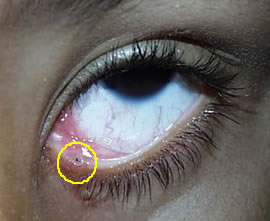![]()
Tampa
(813) 971-3846
![]()
Tampa
(813) 971-3846
 In order for the eye to remain healthy, it must remain moist. The lacrimal gland is a specialized gland located under the outer one-third of the upper eyelid that makes tears. Each time you blink, the eyelid spreads the tears over the surface of the eye and pumps excess tears into a “duct” that drains the tears into your nose.
In order for the eye to remain healthy, it must remain moist. The lacrimal gland is a specialized gland located under the outer one-third of the upper eyelid that makes tears. Each time you blink, the eyelid spreads the tears over the surface of the eye and pumps excess tears into a “duct” that drains the tears into your nose.
If the lacrimal gland fails to produce enough tears to properly wet the eye, the surface of the eye begins to dry out. An eye that is too dry typically burns, stings and feels as if there is sand in it. Artificial tears and lubricating ointments will help control the drying and irritation that occurs when too few tears are produced. However, when adding lubricants to the eye does not adequately relieve the discomfort, closing the openings of the tear drainage system that drains tears from the eye into the nose can help. The closure can be performed temporarily with the insertion of silicone or collagen plugs, or it can be performed more permanently with surgery. In extreme cases, other eyelid procedures may be required to control the drying.
Patients with problems of the lacrimal system are most commonly treated by oculoplastic surgeons who specialize in diseases and conditions affecting the lacrimal system. Information is provided as a general guide and is not to be interpreted as specific advice for individual patients.
In order for the eye to remain healthy, it must remain moist. The lacrimal gland is a specialized gland located under the outer one-third of the upper eyelid that makes tears. Each time you blink, the eyelid spreads the tears over the surface of the eye and pumps excess tears into a “duct” that drains the tears into your nose. That is why your nose runs when you cry.
If the lacrimal gland is producing tears properly and the “duct” that drains the tears from the eye into the nose becomes blocked, the tears will back up and spill over the eyelid and cause tears to run down the face. If one has a plugged up “tear duct,” not only will tears spill over the eyelids and run down the face, but also the stagnant tears within the system can become infected.
An infection within the “tear duct” causes a painful swelling in the inner corner of the eyelids. If the tearing causes severe symptoms, surgery can be performed to bypass the old tear duct and create a new tear duct. This operation is called “dacryocystorhinostomy.” Small silicone tubes are temporarily placed to keep the new tear duct open while healing occurs. Surgical elimination of the obstruction by creating a new tear duct is necessary to eliminate the tearing and infection that can result from such a blockage.
Occasionally, the “tear duct” obstruction will be beyond repair. When this happens, it is necessary to surgically implant an artificial “tear duct” behind the inner corner of the eyelids to drain the tears into the nose. The artificial “tear duct” is made of Pyrex glass and is called a “Jones tube.”
Children are frequently born with an obstruction within the “tear duct.” When this occurs, tearing results. The stagnant tears within the “tear duct” often become infected causing pus (heavy matter) to collect between the eyelids. Such obstructions may resolve on their own within the first few months of life. If not, the oculoplastic surgeon can eliminate this problem with surgical techniques. This may require a “probing” of the lacrimal system in order to unblock the obstruction. If the probing is unsuccessful, then a dacryocystorhinostomy or Jones tube operation (described above) might be required.
Patients with problems of the tear drainage system are most commonly treated by oculoplastic surgeons who specialize in diseases and conditions affecting the lacrimal system.


Phone: (813) 971-3846
Office Hours:
Mon - Fri: 8am - 5pm
5379 Primrose Lake Cir
Tampa, FL 33647
(Inside the office of The Bowman Institute for Dermatologic Surgery)
Phone: (813) 971-3846
©Copyright 2015 J. Justin Eyelid Institute All Rights Reserved.